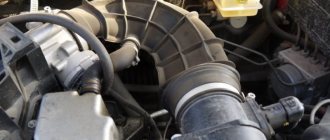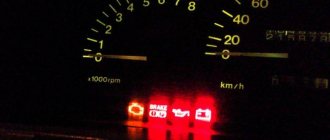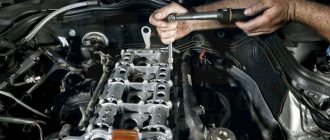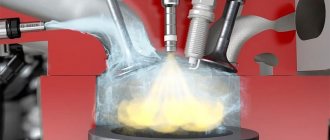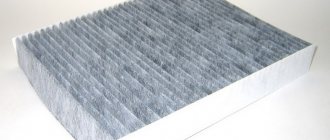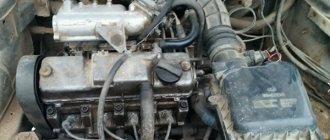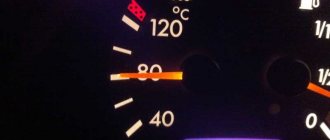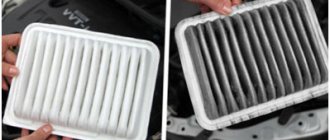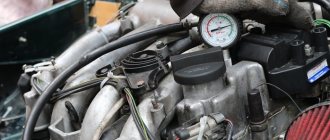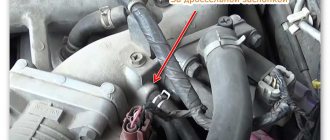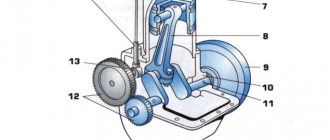What engine size is better and which one to choose for the city
Novice car enthusiasts are often interested in what engine size is best to choose for a city car? First of all, if we consider the technical part, then its power and torque depend on the engine size. Therefore, if you need to get greater performance from the internal combustion engine, then it is made larger. In addition, the larger the internal displacement, the higher the fuel costs. Which internal combustion engine is better, gasoline or diesel, read here. Passenger cars are sometimes equipped with engines with a volume of 8 liters or more.
Which engine displacement is best for city driving?
The size of an engine's internal combustion chambers is measured in liters or cubic centimeters. Let's take a closer look at what the working internal combustion engine of a car affects when operating it in normal everyday conditions. City cars usually have a small size, usually 1.2 - 1.6 liters, since for them the biggest priority is not power, but fuel consumption .
Therefore, this engine size is the best for the city. There are also a large number of cars with 0.8 - 1.0 liters. An example is a popular car in the CIS countries - Daewoo Matiz. It belongs to class A (compact). They have little torque and are intended for driving mainly in the city.
If you turn on the air conditioning on such machines, which takes away 10-20% of the power unit’s thrust, then it will significantly lose acceleration dynamics. Because he will have to turn the air conditioning compressor, which also consumes a lot of energy. Then for normal acceleration it has to be cranked up to 4000 - 5000 rpm, and this is fraught with increased fuel consumption and engine wear . But even at such speeds, gasoline costs will be less than for 1.4 - 1.6 liter engines.
I would like to note that fuel consumption on the highway at an average car speed of 80 - 90 km/h, both with a small volume and a large size of internal combustion chambers, will be the same. Even in some cases, on a car with an internal combustion engine of 0.8 - 1.0, the consumption may be higher.
How many horses should a modern car have - choose by power
Power in a car is one of the main criteria. Today you can find cars with different power ratings, but which solutions to choose for the best quality trip? Sometimes the company's engine offerings are so extensive that the same model is offered with power units from 100 to 250 horsepower. This is what happens, for example, at the British Mini corporation. But experts and experienced drivers call this nonsense and a bad idea. Since each car has a fairly large number of advantages in a specific design. The entire suspension, body, interior elements - everything is calculated for specific power, dynamics and speed. The weight of the engine and other parameters are also important. Therefore, with a large spread, it is difficult to make a good car for each unit at the same time, taking into account all the characteristics.
However, the Mercedes corporation has precedents for how one and the same car can be the optimal offer with an engine of 120 and 350 horsepower. The AMG series has been slightly redesigned in everything - suspension, interior, controls. Therefore, the most powerful cars are often fully justified. However, only a few transport representatives openly behave this way. In most situations there is a specific problem that needs to be solved. And the car solves a specific problem. Therefore, it is often completely useless to install an engine with three hundred horses in an ordinary city car. This simply increases fuel consumption and does not bring any good to the buyer. So you should be more careful when choosing an engine and its technical characteristics.
What does engine size affect?
The average gasoline consumption in the combined cycle (highway - city), for engines with a volume of 0.8 - 1.0 liters, according to the manufacturer's data, averages 5 - 6 liters. per 100 km drive. Engine 1.2 -1.6 average consumption is 6 - 7 liters. . 3 – 5 liters 12 – 18 liters. These are approximate data for new and modern units.
An alternative solution between high power and low fuel consumption is a turbocharged or supercharged engine. With its help, you can significantly increase the efficiency of the engine, on average by 30 - 50%, and at the same time, fuel costs will not increase significantly. For example, the average power of a naturally aspirated (ordinary) unit with a volume of 1.4 liters is 75 – 100 horsepower.
It is called atmospheric because it sucks air into the combustion chambers due to vacuum, that is, when the piston moves down, it draws in air. And if you install a turbocharger on it, its efficiency will rise to 150 -170 hp. pp., since it forcibly inflates air into the cylinders and there is several times more air in it than with atmospheric retraction, and if there is more air in the cylinders, it means more fuel can be supplied. That's where the difference lies.
Origin of internal combustion engines
Most drivers like to discuss the power of their vehicles with friends, as well as read related articles and study ratings. However, not everyone knows how and in what form diesel and gasoline engines existed previously.
Type of internal combustion engine The history of internal combustion engines dates back to the very end of the eighteenth century. So, in 1799, the Frenchman Philippe Lebon patented his invention - a motor that runs on lamp gas, also an open engineer. Since then, a lot of research has followed (mostly unsuccessful) and a number of inventions, thanks to which the engine has become the way we know it.
We recommend: Alternator belt replacement technology
The first gasoline engine appeared after a series of tests and proposals from engineers of that time - they were looking for new types of fuel. Among other mixtures, kerosene was tried, but it differed in that it evaporated poorly. It was replaced by gasoline, previously known only to housewives - it was sold in pharmacies as a cleaning agent. In 1888, Russian Ogneslav Kostovich visited the Department of Trade and Manufactures with a request to issue permission to use the new engine. “Improved, operating with kerosene, gasoline, oil, lighting and other gases and explosives” - this motor has become fundamental in modern production. Kostovich received permission only in 1892. Within 4 years, he managed to patent the invention in the UK and the USA.
Ogneslav Kostovich invented the gasoline engine not to make life easier for motorists, but to create his own airship with an innovative design, including the type of power supply. The project never saw the light of day, but the engine was perfect for ground vehicles. Kostovich's engine had a water cooling system, electric ignition and an opposed cylinder arrangement.
The first diesel engine, the technology of which is also widespread today, has a more popular origin story. It was created by the well-known Rudolf Diesel - the technology and type of fuel are named after him. In 1890, Diesel introduced the idea that for better fuel economy, rapid compression technology should be used. In 1893, Rudolf received a patent for the Diesel engine, and 4 years later he released the first working prototype. The engine was highly efficient, but had too large dimensions, so for a long time gasoline units were the priority.
Engine capacity
Before talking about compression and compression ratio, let's understand the concept of volume. A cylinder has 3 types of volumes:
The total volume includes the working volume and the volume of the combustion chamber. Each engine has a certain number of cylinders. To find out the total engine volume, you need to add up the parameters of each cylinder.
Engine cylinder volumes
To calculate the working volume of one cylinder, you need to multiply the cross-sectional area of the cylinder by the length of the piston stroke. The piston stroke length is determined by the distance from bottom dead center (BDC) to top dead center (TDC), i.e. from the maximum lower to the maximum upper position of the piston.
According to the formula it looks like this: Vwork. = πr 2 h , where π = 3.14, r is the radius, h is the length of the piston stroke.
For example, if the volume of one cylinder is 499 cubic centimeters, and there are four cylinders, then you need to multiply 499 by 4 and we get 1996 cubic centimeters. Next, round to 2000 and divide by 1000 to get the value in liters. Thus, the engine displacement will be 2 liters.
Engine volume is a parameter of the internal combustion engine that determines its power.
In most countries, the cost of car tax depends on the engine displacement. The higher it is, the more expensive the tax is. For example, the engine volume of the Japanese Kei Car is only 0.66 cubic centimeters. Owners of these cars do not pay road tax at all.
The displacement of any engine is measured in cubic centimeters or liters. Based on volume, cars are divided into categories:
- minicar (no more than 1.1 liters);
- small-capacity (from 1.2 to 1.7 liters);
- mid-displacement (from 1.8 to 3.5 liters);
- large-capacity (from 3.6 and more).
The larger the volume, the more fuel-air mixture is placed in each combustion chamber. This indicator directly affects fuel consumption, but at the same time the car’s power increases.
Engine layout, motor location and number of valves
If we talk about various characteristics, engines differ in the number of cylinders, in the arrangement of the cylinders, as well as in the very location of the engine in the engine compartment. For example, power units are 3, 4, 5, 6, 8 cylinders, etc.
Based on the location of the cylinders, in-line, V-shaped, boxer engines, etc. are also distinguished. The power unit can be installed longitudinally or transversely under the hood. Each cylinder can have 2, 4 or more timing valves installed.
Note that you should pay attention to the total number of cylinders only when it comes to choosing a small car. More precisely, not so long ago it became common practice to install three-cylinder naturally aspirated and turbo engines on urban subcompact cars. At the same time, such internal combustion engines with three cylinders are characterized by an increased level of vibration.
In all other cases, the number of cylinders to one degree or another determines the power, while in terms of vibrations it is not so important how many of them a particular engine has, 4, 5 or 6. Often, the location of the internal combustion engine under the hood also plays a minor role.
The only thing is that in practice, many in-line engines with 6 cylinders, installed longitudinally, are characterized by an increased tendency to break down even with slight overheating compared to other analogues.
As a rule, only the layout of the cylinders deserves special attention. There are many layout schemes, the most common being:
The in-line engine on this list is the simplest, the cylinders are in one row above the crankshaft. Such an engine is easier to maintain and repair. The main disadvantage is that increasing the number of cylinders beyond 6 leads to the fact that the engine becomes too long and cannot be placed both longitudinally and transversely in the engine compartment.
We also recommend reading the article about which car engines are the most reliable and durable. From this article you will learn about the most famous and reliable engines, which stand out among all kinds of internal combustion engines due to their long service life.
To solve this problem, a V-shaped engine is installed on the car; the cylinders are arranged not in one, but in two rows, and at an angle to each other. Such internal combustion engines are more complex than in-line engines and are more expensive to maintain and repair. Suffice it to remember that this type of unit has two cylinder heads with all the ensuing consequences. Another disadvantage is the relatively high vibration load.
Only some automakers use boxer engines. In particular, Subaru from Japan specializes in such internal combustion engines; they are also produced by the Germans Porsche. The boxer engine creates a minimum of vibrations, but is extremely difficult to maintain; not all car repair shops can perform high-quality repairs if necessary.
Now let's move on to the valves. Their number directly affects engine power, engine response and a number of other parameters. The more valves, the better the cylinder is filled with the fuel-air mixture and ventilated from exhaust gases. At the same time, an increase in the number of valves naturally leads to the complication and increase in cost of the entire timing structure.
Today, the simplest engines have 2 valves (intake and exhaust) for each cylinder. The most common option on budget cars is an inline four-cylinder 8-valve engine. Such units are the most affordable and easy to repair. At the same time, they are the least powerful and insufficiently economical compared to 16-valve options, etc.
What is compression ratio
The movement of the piston occurs as a result of the pressure of gases that are formed during the combustion of the fuel-air mixture. Before ignition, the mixture is compressed by a piston in the cylinder. The remaining volume in the cylinder after complete compression of the fuel (the volume above the piston at TDC) is called the combustion chamber.
The compression ratio is the ratio of the volume of the combustion chamber to the total volume of the cylinder. It is calculated by the formula: ξ = (Vр + Vс) : Vс , where Vр is the working volume, Vс is the volume of the combustion chamber.
Compression ratio
For example, the total volume of the cylinder is 500 cubic centimeters, and the volume of the combustion chamber is 50 cubic centimeters. Compression by 10 times. This means the compression ratio will be 10:1.
The compression ratio is a ratio and a relative value.
Compression process in diesel engines
Typically, diesel engines have a much higher compression ratio. If in gasoline engines it averages 10:1 - 12:1, then in diesel engines the value can reach from 15:1 to 22:1. The working process in a diesel engine occurs as follows: first, clean air enters the cylinder, which, due to the high degree of compression, is heated to 700-900 ° C. Diesel fuel is injected under high pressure into the combustion chamber as the piston approaches TDC. And since the air is already very hot, after mixing with it, the fuel ignites. Combustion under pressure (without the need for a complex ignition system) is the main advantage of the diesel engine. But, on the other hand, the requirements for tightness are increasing. A high-pressure pump is also required, which is one of the weak points of this type of power unit.
Briefly about compression
If everything is clear with the degree of compression, then let’s move on to the term compression. This concept refers to the maximum level of pressure that occurs in the combustion chamber at the moment before fuel combustion. If the degree of compression is a conditional value, then compression is an absolute value and is measured in atmospheres, kilograms per cubic centimeter (kg/cm 2 ).
Compression is the pressure in the cylinder; the compression ratio is a dimensionless parameter that describes the geometric characteristics of the cylinder.
There is a close connection between these two concepts, but compression is affected not only by the compression level, but also by the tightness of the compression rings and valves, engine temperature, fuel combustion temperature and much more. You can read more about compression in a separate article on our website.
What is affected by engine compression ratio?
It affects the amount of work produced by the engine. The higher the compression ratio, the more energy is released when the fuel-air mixture is burned. Accordingly, this is reflected in the power of the power unit. At the end of the last century, automakers sought to increase power precisely by increasing the compression ratio.
Engine performance and compression ratio
This method has certain limitations. The point is that you cannot compress the mixture indefinitely. There is a certain limit, and if this limit is exceeded, spontaneous ignition of the mixture occurs (detonation). But this rule applies only to gasoline engines.
Compression ratio and octane number of gasoline
It is known that each gasoline engine has a certain octane number of fuel.
The octane number of gasoline determines its knock resistance.
The higher the compression ratio and compression, the higher the octane number the fuel must have. For example, low octane fuel will cause detonation in a high compression engine because... will ignite prematurely. If the compression and compression are low, and high-octane fuel is used, then the engine will not be able to achieve full power, because Higher octane fuels typically burn at a lower temperature and more slowly. Due to the combustion rate being lower than the calculated one, it may happen that during the exhaust phase, a still burning mixture will be released through the valve instead of exhaust gases. Consequently, engine parts will overheat, especially the valves, and they may burn out.
Let's look at engines with different compression ratios and recommended fuel octane numbers:
| Compression ratio | Octane number |
| 5,5 – 7 | 66 – 62 |
| 7 – 7,5 | 72 – 76 |
| 7,5 – 8,5 | 76 – 85 |
| 10 | 92 |
| 10,5 – 12,5 | 95 |
| 12 – 14,5 | 98 |
As you can see, the compression ratio is an important engine parameter. Engine power largely depends on it. The octane number of the fuel and other parameters are also directly related to the compression ratio. It makes sense for every car enthusiast to understand this concept and have an idea of its meaning.
Gasoline engine: carburetor or injection
So, if choosing a car engine comes down to buying a gasoline car, then move on. The vast majority of engines in the CIS are gasoline. In parallel with this, on domestic roads you can find both a large number of cars with injection and carburetor engines.
In short, the injector is a modern solution in the field of fuel injection. This injection is completely electronic; the system itself takes into account how much fuel to supply to the engine, taking into account the operating mode and a number of features.
All processes of fuel supply and internal combustion engine operation control are fully automated. As a result, the injection engine is economical, powerful, and capable of operating stably in different conditions.
Also, the carburetor needs to be serviced much more often, constantly adjusted, tuned and cleaned of contaminants. It is quite obvious that today you should not buy a car with a carburetor, giving preference to a more modern and economical injection engine.
The most important characteristics of engines
Engine volume is the sum of the volume of all cylinders in the car. There can be from four to sixteen. According to this criterion, engines are divided into four types: V up to 1.1 l, V 1.2 - 1.7 l, V 1.8 - 3.5 l and V > 3.5 l. If you buy a car exclusively for city trips, then an engine with a volume of 1.2 - 1.7 liters is quite suitable for you. The engine size will determine the subsequent characteristic - power. The larger it is, the higher the power, but the fuel consumption also increases. Also, the main characteristic is power, which determines the work that a car can perform in a certain unit of time. It is measured in horsepower.
What does engine power depend on?
To better understand this, you need to know how its running potential is calculated. First of all, it depends on the amount of horsepower. This term was coined by James Watt, a Scottish inventor and engineer. This was necessary to calculate the equivalent number of horses required to pull a steam engine - also Watt's project. In 1789, the inventor made a series of mathematical calculations, examining the capabilities of a horse, averaged over a long period of time. So, one horsepower was the equivalent of 735 watts. It is noteworthy that the system for measuring power in watts (W, W) was named after James Watt 64 years after his death.
One way or another, engine power is not a constant quantity. It depends on engine speed. The maximum power of the average motor is approximately 6000 rpm. Of course, no one drives at such speeds - when driving around the city, the tachometer shows approximately 3000 rpm. When driving at half the engine's potential, its power is also halved. To increase the number of revolutions, it is necessary to lower the transmission gear.
It takes some time to gain speed, which does not allow you to mobilize all the horsepower instantly. Torque is responsible for the time it takes to gain speed - the third indicator on which the actual power of the engine depends.
Thus, the actual power of the engine depends not only on the number of horsepower. An equally important factor is the number of revolutions that allow the potential to be realized, as well as the torque, which determines the time spent on this. In addition, power also depends on the mass of the car - the number of liters. With. per ton of weight is called the “specific indicator”.
Engine displacement
This engine characteristic is calculated by adding the volumes of all cylinders. In turn, the working volume of the cylinder is the volume that remains above the piston when it moves from TDC (the position of the maximum distance of the piston from the axis of the crankshaft) to BDC (the position of the minimum distance of the piston from the axis of the crankshaft). It is the engine displacement that determines the power of your steel horse. Promising developments are to reduce or increase engine displacement by turning off certain valves while driving. Thanks to such technologies, the comfort of driving a car will increase, and it will also be possible to save fuel by a fifth of its consumption during normal driving.
Tips for a novice car enthusiast
As already mentioned in the article, from the very beginning you must decide what goals you will pursue when buying a car. If you are buying a car only for driving around urban areas (from work to home and the like), then a small engine will be enough for you. Now let's figure out why. The thing is that medium- and large-displacement engines are very well suited for trips of 100 kilometers or more. You will feel the savings if you roll out this distance every day. But, you see, few of us will travel such long distances every day. Thus, to save money, the best option for you will be a car with a volume of 1.2 - 1.7 liters. If you have firmly decided that you will explore distant territories, then you will like a car with a medium-displacement engine with a volume of approximately 2.4 - 2.8 liters. Such vehicles are capable of doing a lot of work and accommodating a larger number of passengers (for example, a jeep or minibus). Good luck choosing your first car and good luck on the roads!
Let's sum it up
Despite the presence of certain disadvantages, powerful and large engines always remain popular among potential buyers. There are a certain number of motorists who do not want to drive 1-liter engines, but want complete freedom of movement. It is for such buyers that modern manufacturers have such cars in their model line.
It should be noted that the choice of car today is no longer related to engine size. Many technical features influence the behavior of a car on the road. What engines do you prefer and what cars would you like to drive in the near future?
